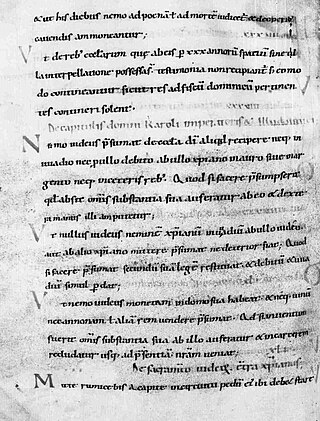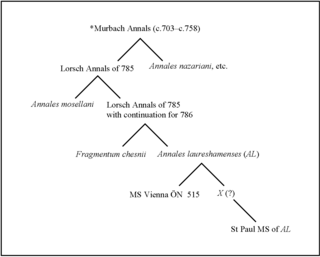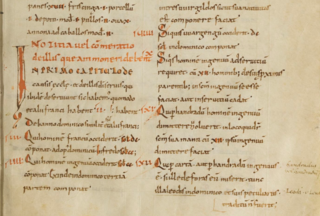
Charlemagne was King of the Franks from 768, King of the Lombards from 774, and Emperor of the Carolingian Empire from 800, holding all these titles until his death in 814. Charlemagne succeeded in uniting the majority of Western Central Europe, and was the first recognized emperor to rule in the west after the fall of the Western Roman Empire approximately three centuries earlier. Charlemagne's rule saw a program of political and social changes that had a lasting impact on Europe in the Middle Ages.

Abul-Abbas was an Asian elephant brought back to the Carolingian emperor Charlemagne by his diplomat Isaac the Jew. The gift was from the Abbasid caliph Harun al-Rashid and symbolizes the beginning of Abbasid–Carolingian relations. The elephant's name and events from his life are recorded in the Carolingian Annales regni Francorum, and he is mentioned in Einhard's Vita Karoli Magni. However, no references to the gift or to interactions with Charlemagne have been found in Abbasid records.
A missus dominicus, Latin for "envoy[s] of the lord [ruler]" or palace inspector, also known in Dutch as Zendgraaf, meaning "sent Graf", was an official commissioned by the Frankish king or Holy Roman Emperor to supervise the administration, mainly of justice, in parts of his dominions too remote for frequent personal visits. As such, the missus performed important intermediary functions between royal and local administrations. There are superficial points of comparison with the original Roman corrector, except that the missus was sent out on a regular basis. Four points made the missi effective as instruments of the centralized monarchy: the personal character of the missus, yearly change, isolation from local interests and the free choice of the king.

The Royal Frankish Annals, also called the Annales Laurissenses maiores, are a series of annals composed in Latin in the Carolingian Francia, recording year-by-year the state of the monarchy from 741 to 829. Their authorship is unknown, though Wilhelm von Giesebrecht suggested that Arno of Salzburg was the author of an early section surviving in the copy at Lorsch Abbey. The Annals are believed to have been composed in successive sections by different authors, and then compiled.
Liber Historiae Francorum is a chronicle written anonymously during the 8th century. The first sections served as a secondary source for early Franks in the time of Marcomer, giving a short breviarum of events until the time of the late Merovingians. The subsequent sections of the chronicle are important primary sources for the contemporaneous history. They provide an account of the Pippinid family in Austrasia before they became the most famous Carolingians.
A capitulary was a series of legislative or administrative acts emanating from the Frankish court of the Merovingian and Carolingian dynasties, especially that of Charlemagne, the first emperor of the Romans in the west since the collapse of the Western Roman Empire in the late 5th century. They were so called because they were formally divided into sections called capitula.

On 7 November 921, the Treaty of Bonn, the text of which calls itself a "pact of friendship" (amicitia), was signed between Charles III of France and Henry I of Germany in a minimalist ceremony aboard a ship in the middle of the Rhine not far from Bonn. The use of the river, which was the border between their two kingdoms, as a neutral territory had extensive Carolingian precedents and was also used in classical antiquity and in contemporary Anglo-Saxon England.
The Lex Saxonum are a series of laws issued by Charlemagne between 782 and 803 as part of his plan to subdue the Saxon nation. The law is thus a compromise between the traditional customs and statutes of the pagan Saxons and the established laws of the Frankish Empire.
Benedict Levita, or Benedict the Deacon, is the pseudonym attached to a forged collection of capitularies that appeared in the ninth century.
The Lex Ripuaria, also spelled Lex Ribuaria, is a 7th-century collection of Germanic law, the laws of the Ripuarian Franks. It is a major influence on the Lex Saxonum of AD 802. The Lex Ripuaria originated about 630 around Cologne and has been described as a later development of the Frankish laws known from Lex Salica.

The Capitulary for the Jews is a set of six short legal prescriptions concerning Jews in the Carolingian Empire. They were gathered together and published under the title by which they are now known by Alfred Boretius in 1883, but only the first three and possibly the fourth are derived from a single source; the fifth and sixth are from an unrelated source. In one manuscript, the sixth "chapter" (capitulum) is said to have been taken "from Emperor Charles' statutes", indicating either Charlemagne or Charles the Bald. Its content, however, is inconsistent with the known Jewish policies of these emperors.
The anonymous Saxon poet known as Poeta Saxo, who composed the medieval Latin Annales de gestis Caroli magni imperatoris libri quinque was probably a monk of Saint Gall or possibly Corvey. His Annales is one of the earliest poetic treatments of annalistic material and one of the earliest historical works to concentrate on Saxony. It is considered characteristic of the dénouement of the Carolingian Renaissance.

The Fragmentum (annalium) chesnii or chesnianum, sometimes called the Annales Laureshamenses antiquiores, is a brief set of Reichsannalen describing the history of Francia during the years 768 to 790. It is named after André Duchesne, who first edited and published it in his book Historiae Francorum scriptores (1:21–23) in 1636. It has been re-edited by Georg Heinrich Pertz for the Monumenta Germaniae Historica, Scriptores I, 30–34.

The Annales mosellani or mosellenses (AM) or Moselle Annals are a set of minor Reichsannalen covering the years 703 to 798. Its entries are brief and unliterary, but broad in scope and generally accurate. They have only partially been translated into English.
The Admonitio generalis is a collection of legislation known as a capitulary issued by Charlemagne in 789, which covers educational and ecclesiastical reform within the Frankish kingdom. Capitularies were used in the Frankish kingdom during the Carolingian dynasty by government and administration bodies and covered a variety of topics, sorted into chapters. Admonitio generalis is actually just one of many Charlemagne's capitularies that outlined his desire for a well-governed, disciplined Christian Frankish kingdom. The reforms issued in these capitularies by Charlemagne during the late 8th century reflect the cultural revival known as the Carolingian Renaissance.

The Old Saxon Baptismal Vow, also called the Old Saxon Catechism, Utrecht Baptismal Vow and Abrenuntiatio Diaboli, is a baptismal vow that was found in a ninth-century manuscript in a monastery library in Mainz, Germany. The vow mentions three Germanic pagan gods of the early Saxons which the reader is to forsake: Uuôden ("Woden"), Thunaer and Saxnōt. Scholar Rudolf Simek comments that the vow is of particular interest because it is the sole instance of the god Saxnōt mentioned in a religious context. One of many baptismal vows, it is now archived in the Vatican Codex pal. 577.

The Indiculus superstitionum et paganiarum is a Latin collection of capitularies identifying and condemning superstitious and pagan beliefs found in the north of Gaul and among the Saxons during the time of their subjugation and conversion by Charlemagne.
Wulfar or Wulfaire was the archbishop of Reims from 812 until his death. He was an important administrator in the Carolingian Empire, both before and during his episcopate, under the emperors Charlemagne and Louis the Pious.

Ewa ad Amorem, traditionally known as the Lex Francorum Chamavorum, is a 9th-century law code from the Carolingian Empire. It is generally counted among the leges barbarorum, but it was not a national law. It applied only to a certain region in the Low Countries, although exactly where is disputed. Its association with the Chamavi is a modern conjecture.
The Annales Tiliani are an anonymous set of Latin annals from the Frankish kingdom, covering the years 708–807. They are considered minor annals.